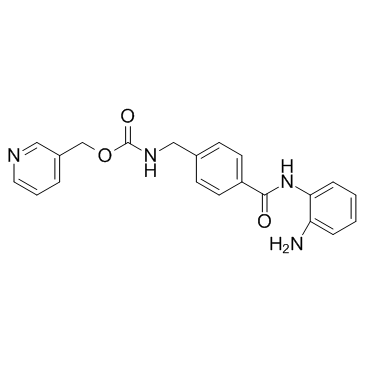
Entinostat
CAS No. 209783-80-2
Entinostat( MS-275 | SNDX-275 | MS 275 | SNDX 275 )
Catalog No. M13310 CAS No. 209783-80-2
A potent and selective class I HDACs inhibitor with IC50 of 243/453/248 nM for HDAC1/2/3.
Purity : >98% (HPLC)
 COA
COA
 Datasheet
Datasheet
 HNMR
HNMR
 HPLC
HPLC
 MSDS
MSDS
 Handing Instructions
Handing Instructions
| Size | Price / USD | Stock | Quantity |
| 10MG | 45 | In Stock |


|
| 25MG | 65 | In Stock |


|
| 50MG | 81 | In Stock |


|
| 100MG | 113 | In Stock |


|
| 200MG | 174 | In Stock |


|
| 500MG | Get Quote | In Stock |


|
| 1G | Get Quote | In Stock |


|
Biological Information
-
Product NameEntinostat
-
NoteResearch use only, not for human use.
-
Brief DescriptionA potent and selective class I HDACs inhibitor with IC50 of 243/453/248 nM for HDAC1/2/3.
-
DescriptionA potent and selective class I HDACs inhibitor with IC50 of 243/453/248 nM for HDAC1/2/3; no inhibition on HDAC8/4/5/7/9/6/10 (IC50>10 uM); induces accumulation of p21WAF1/CIP1 and gelsolin in K562 cell; reduce S-phase cells and induce G1-phase cells in A2780 cell.Breast Cancer Phase 3 Clinical(In Vitro):Binding affinity of Entinostat (MS-275) against HDAC1 and HDAC2 is 282 nM and 156 nM, respectively. Effects of the HDAC inhibitor Entinostat (MS-275) have been examined in human leukemia and lymphoma cells (U937, HL-60, K562, and Jurkat) as well as in primary acute myelogenous leukemia blasts in relation to differentiation and apoptosis. MS-275 displays dose-dependent effects in each of the cell lines. When administered at a low concentration (e.g., 1 μM), MS-275 exhibits potent antiproliferative activity, inducing p21CIP1/WAF1-mediated growth arrest and expression of differentiation markers (CD11b) in U937 cells. Entinostat (MS-275) potently induces cell death, triggering apoptosis in ~70% of cells at 48 h. (In Vivo):Entinostat (MS-27-275) at 49 mg/kg shows marked antitumor effects against KB-3-1, 4-1St, and St-4 tumor lines, and a moderate effect against Capan-1 tumor. Entinostat at 24.5 mg/kg and 12.3 mg/kg also shows significant effects against these tumors. In addition, oral administration of Entinostat apparently increases the level of histone acetylation in HT-29 tumor xenografts 4-24 h after the administration. MS-275 administration (3.5 mg/kg i.p.) to Experimental autoimmune neuritis (EAN) rats once daily from the appearance of first neurological signs greatly reduces the severity and duration of EAN and attenuated local accumulation of macrophages, T cells and B cells, anddemyelination of sciatic nerves. In addition, MS-275 treatment increases proportion of infiltrated Foxp3+ cells and anti-inflammatory M2 macrophages in sciatic nerves of EAN rats.
-
In VitroBinding affinity of Entinostat (MS-275) against HDAC1 and HDAC2 is 282 nM and 156 nM, respectively. Effects of the HDAC inhibitor Entinostat (MS-275) have been examined in human leukemia and lymphoma cells (U937, HL-60, K562, and Jurkat) as well as in primary acute myelogenous leukemia blasts in relation to differentiation and apoptosis. MS-275 displays dose-dependent effects in each of the cell lines. When administered at a low concentration (e.g., 1 μM), MS-275 exhibits potent antiproliferative activity, inducing p21CIP1/WAF1-mediated growth arrest and expression of differentiation markers (CD11b) in U937 cells. Entinostat (MS-275) potently induces cell death, triggering apoptosis in ~70% of cells at 48 h.
-
In VivoEntinostat (MS-27-275) at 49 mg/kg shows marked antitumor effects against KB-3-1, 4-1St, and St-4 tumor lines, and a moderate effect against Capan-1 tumor. Entinostat at 24.5 mg/kg and 12.3 mg/kg also shows significant effects against these tumors. In addition, oral administration of Entinostat apparently increases the level of histone acetylation in HT-29 tumor xenografts 4-24 h after the administration. MS-275 administration (3.5 mg/kg i.p.) to Experimental autoimmune neuritis (EAN) rats once daily from the appearance of first neurological signs greatly reduces the severity and duration of EAN and attenuated local accumulation of macrophages, T cells and B cells, anddemyelination of sciatic nerves. In addition, MS-275 treatment increases proportion of infiltrated Foxp3+ cells and anti-inflammatory M2 macrophages in sciatic nerves of EAN rats.
-
SynonymsMS-275 | SNDX-275 | MS 275 | SNDX 275
-
PathwayCell Cycle/DNA Damage
-
TargetHDAC
-
RecptorHDAC1|HDAC3
-
Research AreaCancer
-
IndicationBreast Cancer
Chemical Information
-
CAS Number209783-80-2
-
Formula Weight376.4085
-
Molecular FormulaC21H20N4O3
-
Purity>98% (HPLC)
-
Solubility10 mM in DMSO
-
SMILESO=C(OCC1=CC=CN=C1)NCC2=CC=C(C(NC3=CC=CC=C3N)=O)C=C2
-
Chemical NameCarbamic acid, N-[[4-[[(2-aminophenyl)amino]carbonyl]phenyl]methyl]-, 3-pyridinylmethyl ester
Shipping & Storage Information
-
Storage(-20℃)
-
ShippingWith Ice Pack
-
Stability≥ 2 years
Reference
1. Saito A, et al. Proc Natl Acad Sci U S A. 1999 Apr 13;96(8):4592-7.
2. Lauffer BE, et al. J Biol Chem. 2013 Sep 13;288(37):26926-43.
3. Rosato RR, et al. Cancer Res, 2003, 63(13), 3637-3645.
molnova catalog



related products
-
1-Naphthohydroxamic ...
1-Naphthohydroxamic acid (Compound 2) is a potent and selective HDAC8 inhibitor with an IC50 of 14 μM, and it is more selectively for HDAC8 than class I HDAC1 and class II HDAC6 (IC50 >100 μM).
-
Givinostat
Givinostat or gavinostat, aslo known as ITF2357, is a potent and orally active histone deacetylase inhibitor with potential anti-inflammatory, anti-angiogenic, and antineoplastic activities.
-
Class I and IIB HDAC...
Class I and IIB HDAC inhibitor 42 is a novel potent, selective class I and IIB inhibitor.



 Cart
Cart
 sales@molnova.com
sales@molnova.com


